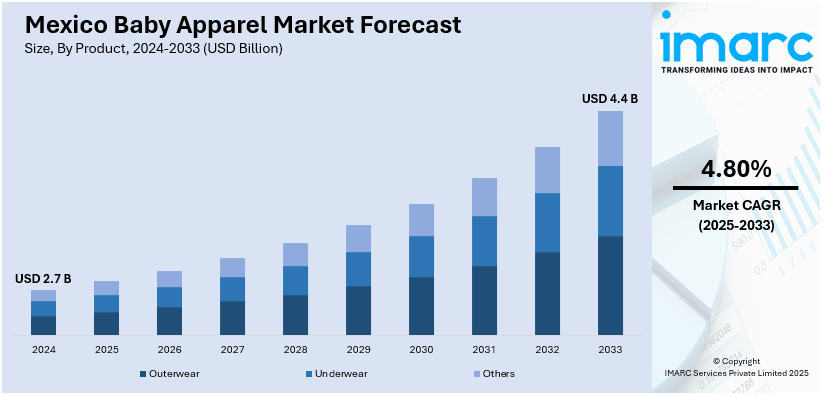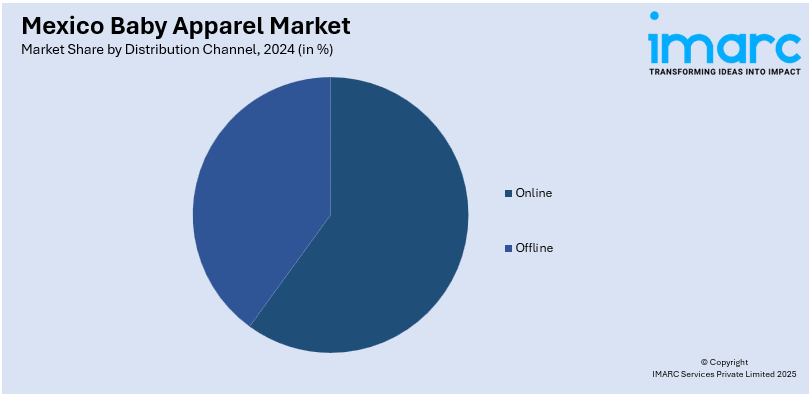
Mexico Baby Apparel Market Size, Share, Trends and Forecast by Product, Material, Distribution Channel, Age Group, End User, and Region, 2025-2033
Mexico Baby Apparel Market Overview:
The Mexico baby apparel market size reached USD 2.7 Billion in 2024. Looking forward, IMARC Group expects the market to reach USD 4.4 Billion by 2033, exhibiting a growth rate (CAGR) of 4.80% during 2025-2033. Rising urban birth rates, evolving preferences of millennial and Gen Z parents, increasing urbanization, higher disposable incomes, expanding retail networks, rapid e-commerce penetration, growing sustainability trends, and rising demand for premium and organic fabrics are factors propelling the market growth.
|
Report Attribute
|
Key Statistics
|
|---|---|
|
Base Year
|
2024 |
|
Forecast Years
|
2025-2033
|
|
Historical Years
|
2019-2024
|
| Market Size in 2024 | USD 2.7 Billion |
| Market Forecast in 2033 | USD 4.4 Billion |
| Market Growth Rate 2025-2033 | 4.80% |
Mexico Baby Apparel Market Trends:
Rising Birth Rates
The high birth rates in the large metropolitan cities, such as Mexico City, Guadalajara, and Monterrey, is one of the key factors boosting the Mexico baby clothing market share. These cities account for a majority of the country's annual births, supported by enhanced healthcare access, high awareness of maternal health, and demographic momentum. Moreover, the growing concentration of young families in these locations has led to demand for infant and toddler apparel, especially from first-time parents, that are willing to spend on good-quality apparel, which is another growth-inducing factor. Urban families also receive greater exposure to branded and organized retail stores, both online and offline, to select from a wider variety of products. This demographic shift has prompted local and international fashion brands to expand their presence in these cities, tailoring ranges to suit regional climate, tastes, and spending capacities.

Changing Preferences Among Millennial and Gen Z Parents
Millennial and Gen Z consumers are bringing a strong influence on style, digital savviness, and values-based purchasing to the baby apparel space. They are actively looking for baby apparel with minimalism, gender-neutral design, and multipurpose clothing items. In addition to this, surging social media influence play an increasingly important role in the purchase patterns, with a collective majority of these consumers seeking baby apparel online, which is another factor strengthening the Mexican baby apparel market growth. Their willingness to try new labels, particularly those with comfort-driven, sustainable, or aesthetically curated collections, has fueled demand for innovation in design and marketing. In line with this, key manufacturers are trying to tap into the consumer base and are embracing influencer-led campaigns, digital-first retail, and focused seasonal collections that reflect changing style sensibilities, which is facilitating the market growth.
Increased Urbanization Driving Retail Access
Rapid urbanization in Mexico is reshaping the retailing environment and influencing baby clothing marketing and distribution. For instance, the urban population in Mexico was 82.0% in 2025, a 0.4% point growth from the previous year. The growth is a reflection of ongoing urbanization, with additional individuals residing in urban areas. The total population was 131 million, equivalent to a 0.8% annual growth. As more households move to cities, access to organized retail platforms, such as shopping malls, brand stores, and supermarkets, has grown, favoring the Mexico baby clothing market outlook. These channels offer standardized quality, brand options, and a more consistent experience than informal channels. Moreover, the expansion of multi-brand baby stores and department store chains in tier-2 and tier-1 cities has allowed for increased product discovery, especially among high- and mid-income consumers, which is accelerating the market growth. Apart from this, urbanization has also enabled the emergence of support infrastructure, such as warehousing and last-mile delivery, necessary for the expansion of e-commerce baby wear platforms, which is fostering the market growth.
Mexico Baby Apparel Market Segmentation:
IMARC Group provides an analysis of the key trends in each segment of the market, along with forecasts at the region level for 2025-2033. Our report has categorized the market based on product, material, distribution channel, age group, and end user.
Product Insights:
- Outerwear
- Underwear
- Others
The report has provided a detailed breakup and analysis of the market based on the product. This includes outerwear, underwear, and others.
Material Insights:
- Cotton
- Wool
- Silk
A detailed breakup and analysis of the market based on the material have also been provided in the report. This includes cotton, wool, and silk.
Distribution Channel Insights:

- Online
- Offline
The report has provided a detailed breakup and analysis of the market based on the distribution channel. This includes online and offline.
Age Group Insights:
- 0-12 Months
- 12-24 Months
- 2-3 Years
A detailed breakup and analysis of the market based on the age group have also been provided in the report. This includes 0-12 months, 12-24 months, and 2-3 years.
End User Insights:
- Girls
- Boys
The report has provided a detailed breakup and analysis of the market based on the end user. This includes girls and boys.
Regional Insights:
- Northern Mexico
- Central Mexico
- Southern Mexico
- Others
The report has also provided a comprehensive analysis of all the major regional markets, which include Northern Mexico, Central Mexico, Southern Mexico, and others.
Competitive Landscape:
The market research report has also provided a comprehensive analysis of the competitive landscape. Competitive analysis such as market structure, key player positioning, top winning strategies, competitive dashboard, and company evaluation quadrant has been covered in the report. Also, detailed profiles of all major companies have been provided.
Mexico Baby Apparel Market News:
- In 2025, Carter's launched its inaugural Spring Break capsule collection, curated by social media sensation Baby Kate. The line features nautical and boho swimwear with UPF 50+ protection, cozy layering knits, and matching sets, all designed with parent-friendly details like snaps and elastic for easy changes.
Mexico Baby Apparel Market Report Coverage:
| Report Features | Details |
|---|---|
| Base Year of the Analysis | 2024 |
| Historical Period | 2019-2024 |
| Forecast Period | 2025-2033 |
| Units | Billion USD |
| Scope of the Report |
Exploration of Historical Trends and Market Outlook, Industry Catalysts and Challenges, Segment-Wise Historical and Future Market Assessment:
|
| Products Covered | Outerwear, Underwear, Others |
| Materials Covered | Cotton, Wool, Silk |
| Distribution Channels Covered | Online, Offline |
| Age Groups Covered | 0-12 Months, 12-24 Months, 2-3 Years |
| End Users Covered | Girls, Boys |
| Regions Covered | Northern Mexico, Central Mexico, Southern Mexico, Others |
| Customization Scope | 10% Free Customization |
| Post-Sale Analyst Support | 10-12 Weeks |
| Delivery Format | PDF and Excel through Email (We can also provide the editable version of the report in PPT/Word format on special request) |
Key Questions Answered in This Report:
- How has the Mexico baby apparel market performed so far and how will it perform in the coming years?
- What is the breakup of the Mexico baby apparel market on the basis of product?
- What is the breakup of the Mexico baby apparel market on the basis of material?
- What is the breakup of the Mexico baby apparel market on the basis of distribution channel?
- What is the breakup of the Mexico baby apparel market on the basis of age group?
- What is the breakup of the Mexico baby apparel market on the basis of end user?
- What is the breakup of the Mexico baby apparel market on the basis of region?
- What are the various stages in the value chain of the Mexico baby apparel market?
- What are the key driving factors and challenges in the Mexico baby apparel?
- What is the structure of the Mexico baby apparel market and who are the key players?
- What is the degree of competition in the Mexico baby apparel market?
Key Benefits for Stakeholders:
- IMARC’s industry report offers a comprehensive quantitative analysis of various market segments, historical and current market trends, market forecasts, and dynamics of the Mexico baby apparel market from 2019-2033.
- The research report provides the latest information on the market drivers, challenges, and opportunities in the Mexico baby apparel market.
- Porter's five forces analysis assist stakeholders in assessing the impact of new entrants, competitive rivalry, supplier power, buyer power, and the threat of substitution. It helps stakeholders to analyze the level of competition within the Mexico baby apparel industry and its attractiveness.
- Competitive landscape allows stakeholders to understand their competitive environment and provides an insight into the current positions of key players in the market.
Need more help?
- Speak to our experienced analysts for insights on the current market scenarios.
- Include additional segments and countries to customize the report as per your requirement.
- Gain an unparalleled competitive advantage in your domain by understanding how to utilize the report and positively impacting your operations and revenue.
- For further assistance, please connect with our analysts.
 Request Customization
Request Customization
 Speak to an Analyst
Speak to an Analyst
 Request Brochure
Request Brochure
 Inquire Before Buying
Inquire Before Buying




.webp)




.webp)












